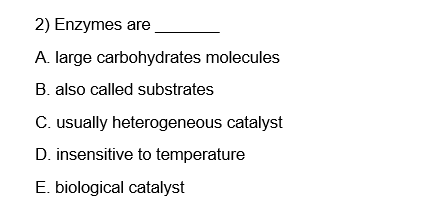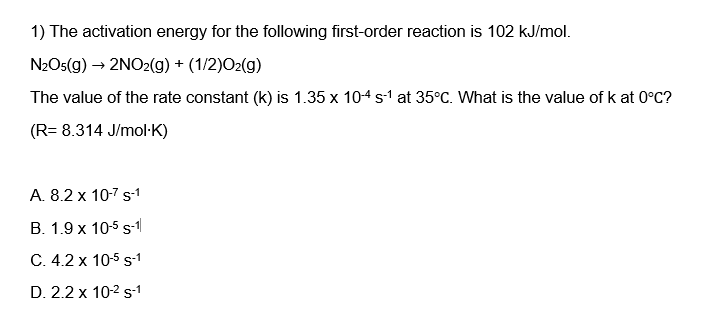1) The activation energy for the following first-order reaction is 102 kJ/mol. N₂O5(g) → 2NO2(g) + (1/2)0₂(g) The value of the rate constant (k) is 1.35 x 10-4 s-¹ at 35°C. What is the value of k at 0°C? (R= 8.314 J/mol-K) A. 8.2 x 10-7 s-1 B. 1.9 x 10-5 S-1 C. 4.2 x 10-5 sS-1 D. 2.2 x 10-² S-1
1) The activation energy for the following first-order reaction is 102 kJ/mol. N₂O5(g) → 2NO2(g) + (1/2)0₂(g) The value of the rate constant (k) is 1.35 x 10-4 s-¹ at 35°C. What is the value of k at 0°C? (R= 8.314 J/mol-K) A. 8.2 x 10-7 s-1 B. 1.9 x 10-5 S-1 C. 4.2 x 10-5 sS-1 D. 2.2 x 10-² S-1
Chemistry & Chemical Reactivity
9th Edition
ISBN:9781133949640
Author:John C. Kotz, Paul M. Treichel, John Townsend, David Treichel
Publisher:John C. Kotz, Paul M. Treichel, John Townsend, David Treichel
Chapter14: Chemical Kinetics: The Rates Of Chemical Reactions
Section: Chapter Questions
Problem 23PS: The decomposition of ammonia on a metal surface to form N2 and H2 is a zero-order reaction (Figure...
Related questions
Question
General Chemistry for Engineers
Lesson:
Directions: Answer the following problems by showing the complete solution. In return, I will give you a good and high rating. Thank you so much!
Note: Please be careful with the units and measurements in calculations. Thank you!
No. 1-2.

Transcribed Image Text:2) Enzymes are
A. large carbohydrates molecules
B. also called substrates
C. usually heterogeneous catalyst
D. insensitive to temperature
E. biological catalyst

Transcribed Image Text:1) The activation energy for the following first-order reaction is 102 kJ/mol.
N2O5(g) → 2NO2(g) + (1/2)O2(g)
The value of the rate constant (k) is 1.35 x 10-4 s-¹ at 35°C. What is the value of k at 0°C?
(R= 8.314 J/mol-K)
A. 8.2 x 10-7 s-1
B. 1.9 x 10-5 S-1
C. 4.2 x 10-5 S-1
D. 2.2 x 10-2 s-1
Expert Solution
This question has been solved!
Explore an expertly crafted, step-by-step solution for a thorough understanding of key concepts.
Step by step
Solved in 3 steps with 3 images

Knowledge Booster
Learn more about
Need a deep-dive on the concept behind this application? Look no further. Learn more about this topic, chemistry and related others by exploring similar questions and additional content below.Recommended textbooks for you

Chemistry & Chemical Reactivity
Chemistry
ISBN:
9781133949640
Author:
John C. Kotz, Paul M. Treichel, John Townsend, David Treichel
Publisher:
Cengage Learning

Chemistry & Chemical Reactivity
Chemistry
ISBN:
9781337399074
Author:
John C. Kotz, Paul M. Treichel, John Townsend, David Treichel
Publisher:
Cengage Learning

Chemistry for Engineering Students
Chemistry
ISBN:
9781337398909
Author:
Lawrence S. Brown, Tom Holme
Publisher:
Cengage Learning

Chemistry & Chemical Reactivity
Chemistry
ISBN:
9781133949640
Author:
John C. Kotz, Paul M. Treichel, John Townsend, David Treichel
Publisher:
Cengage Learning

Chemistry & Chemical Reactivity
Chemistry
ISBN:
9781337399074
Author:
John C. Kotz, Paul M. Treichel, John Townsend, David Treichel
Publisher:
Cengage Learning

Chemistry for Engineering Students
Chemistry
ISBN:
9781337398909
Author:
Lawrence S. Brown, Tom Holme
Publisher:
Cengage Learning


Chemistry
Chemistry
ISBN:
9781305957404
Author:
Steven S. Zumdahl, Susan A. Zumdahl, Donald J. DeCoste
Publisher:
Cengage Learning
